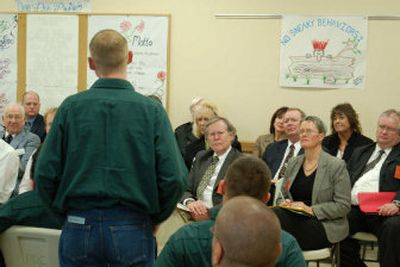Lawmakers tour prisons outside Boise

BOISE – Space for housing the severely mentally ill and rehabilitating drug offenders is lacking in Idaho prisons, legislators learned firsthand Tuesday on a tour of state lockups south of Boise.
Lawmakers visited a crowded mental health ward, talked with inmates in a coveted treatment program and toured a semipermanent but flimsy structure housing inmates.
Rep. Nicole LeFavour, D-Boise, said it’s “appalling” that budgets for beds and programming haven’t grown because of a “lack of funding by the Legislature over time.”
Rep. Marge Chadderdon, R-Coeur d’Alene, said it’s important for legislators to see the inside of Idaho prisons, even though she doesn’t always like being watched by prisoners.
More than two dozen legislators boarded a white Idaho Department of Correction bus at the steps of the Capitol, walking past crates of gleaming silver handcuffs just inside the door. They sat behind barred windows for the drive to the prison complex.
At their first stop, legislators walked through rows of chain-link fence topped by razor wire, trading a sunny January day for the dark, stuffy confines of the building that houses the state’s most dangerous criminals – the Idaho Maximum Security Institution.
With beds for 517 prisoners, the facility is home to 190 criminals on “administrative segregation.” They are confined to solitary cells to control their movement, Warden John Hardison said.
The inmates include 19 sentenced to death and three mentally ill prisoners committed under state law.
The latter were deemed too dangerous for state hospitals, which do not have sufficient security measures, said Dr. Mary Perrien, chief of the correction department’s division of education and treatment.
“So they come to us,” a situation that’s “not ideal,” she said.
Lawmakers toured a central control room in C-Block, which houses the mental health ward. From the room, officers monitor prisoner behavior through windows and cameras.
While the prison houses a few of the dangerously mentally ill, the Department of Health and Welfare estimates space is needed for far more of them, Perrien said.
At the next stop, the medium-security Idaho State Correctional Institution, a German shepherd barked at lawmakers as they entered the visitors’ center.
They sat at metal tables near murals of Disney movie characters painted on the walls by some of the facility’s 1,490 male prisoners.
Later they toured a new, semipermanent “sprung” building used as a medical annex to house low-threat, aging inmates.
In his State of the State message Monday, Gov. Butch Otter proposed building another sprung building.
He said they are one way to meet the need for inexpensive prison space.
The building, finished in September, cost about $1.47 million, about $3 million less than a traditional building.
Made by stretching a cloth membrane over a metal frame, it resembles a salmon-and-white circus tent and offers dorm-style bunks in the center and showers and bathrooms.
But it only can be used for low-security prisoners.
“If you have a sharpened pencil, you could probably push right through it,” said Keith Yordy, a deputy warden.
The state also owns a nearby, privately operated prison that can house roughly 1,500. Mentally ill and more dangerous prisoners are kept in the state-run facility, said Pam Sonnen, chief of prisons.
“We don’t send the really bad guys over to the private prison,” she said. “Not that there are really bad guys here.”
Because the prison won’t release inmates until they have completed programs designed to help them succeed outside the wire, some prisoners must wait 18 months or more beyond their expected time of release on parole, she said.
Only about two-thirds of inmates can enter programs under current funding levels.
“They’re having to stay longer in prison to get the programming that they need,” Sonnen said.
Lawmakers ended the tour at the South Idaho Correctional Institution’s Parole Release Center, which provides a nine- to 12-month program designed to treat high-risk substance abuse offenders.
“We have a little cramped quarters here,” said Warden Gary Barrier as legislators crammed into the foyer of the 100-bed, dormitory-style facility.
Opened in 2001, the center is one of three “therapeutic communities” within the Idaho prison system. During treatment, inmates learn to communicate and deal with life’s difficulties without turning to drugs and alcohol.
Legislators sat in on one of the program’s prisoner-led daily meetings, at which inmates offer each other positive encouragement and share their struggles.
Dressed in matching blue jeans and green shirts emblazoned with “TEAM,” the members greeted new speakers in unison and clapped loudly after each presentation.
Afterward, a legislator asked the group how many were jailed for meth addiction. Most raised their hands.
When asked how many became addicted in high school, a forest of green arms shot up.
“This program helps us see what we were like. It gives us hope for what we can be like,” said program graduate Donald May, 45. “It helps us make that turn.”
Men like those in the program are 21 percent more likely to re-offend if they are not in the program, Sonnen said.
But the system is “not even meeting 50 percent of the need” for treatment programs, Perrien said.